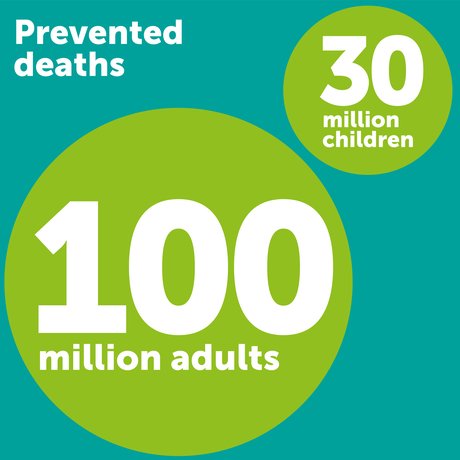Key message
Key challenges
- Reducing investment in education leads to greater health cost burdens on government budgets. In the US, reduced spending in education led to more illness and higher medical care costs that offset the intended 'savings' of the same budget cuts.
(AAFP, 2015) - School closures could have significant health consequences. The closure of schools for long periods of time could have great social and health consequences for children and could exacerbate existing inequalities, widen the gap in educational attainment between pupils and possibly undo previous progress. During COVID, approximately 365 million primary school students went without school meals and reported increased rates of stress, anxiety and other mental health issues.
(The Lancet, 2020) (WHO, 2021)
Make the case
- An educated mother provides a wealth of life-saving health benefits to her child. A child whose mother can read is 50% more likely to live past the age of five, 50% more likely to be immunised, and twice as likely to attend school. In Bangladesh, an extra year of maternal schooling reduces under five mortality by 21.54% and infant mortality by 22.54%.
(International Commission on Financing Global Education Opportunity, 2017) (Wu, 2022) - Without investments in education, there will be a severe shortage of health workers. Without increased investment in education, by 2030 there will be a shortage of 15 million health workers worldwide – double what it is today.
(Liu et al., 2017) - Educating girls saves lives Half of the reduction in under-five child mortality over nearly 40 years can be attributed to an increase in girls' education. Educating girls has prevented the deaths of more than 30 million children under five and 100 million adults.
(Gakidou et al., 2010) (International Commission on Financing Global Education Opportunity, 2016) - Educated women have a better understanding of healthy behaviour for themselves and for their children. In Peru, a country with one of the highest rates of maternal mortality in the Western hemisphere, it has been shown that increasing women's education decreases the probability of short birth intervals and unwanted pregnancies.
(Weitzman, 2017) - A marginal increase in education yields tremendous decreases in pneumonia cases, the leading cause of child death worldwide. One additional year of maternal education reduces the pneumonia death rate by 14%, saving 160,000 child lives every year.
(EFA GMR, 2014) - Investing in education delivers impressive and lasting health returns to society. Each US dollar invested in a one-year increase in schooling generates a health-inclusive benefit of US$10 in low-income countries.
(Jamison & Schaferhoff, 2016) - The child of an educated parent is more likely to access malaria prevention and treatment services and survive childhood. In the Democratic Republic of the Congo — where 20% of the world’s malaria-related deaths occur — the probability of using a bed net increased by 75% if the head of household had completed primary education. 50% of preventable school absenteeism in Africa can be attributed to malaria.
(Ndjinga & Minakawa, 2010) (Malaria No More, 2020) - Education is a cost-effective tool for preventing HIV transmission, providing the knowledge to reduce the risk of infection. If all young adults completed primary education, there would be seven million fewer new cases of HIV per decade. Girls out-of-school are three times more likely to be infected with HIV than those in school. Staying in secondary school can reduce HIV infection rates by as much as 60%.
(Malala Fund, 2015) (Grepin & Bharadwaj, 2015) (De Neve et al., 2015) - Girls’ education saves lives. Around one-third of the reductions in adult mortality and nearly 15% of the reductions in infant mortality from 1970 to 2010 can be attributed to gains in female schooling.
(Jamison & Schaferhoff, 2016) - Good health promotes learning. In developing countries an estimated 500 million days of school per year are lost due to sickness.
(World Bank, 2018) - A focus on children's health increases enrolment rates. Nutritious school meals increase school enrolment rates by 9% on average, and attendance by 8%. These meals can also reduce anemia in adolescent girls by up to 20%. Improving water and sanitation services in schools as well as information on menstrual hygiene equips girls to maintain their body hygiene and health with dignity and can limit the number of school days missed during menstruation.
(WHO, 2021)
Key infographic

Half of the reduction in under-five child mortality over nearly 40 years can be attributed to an increase in girls' education.
Educating girls prevented the deaths of more than 30 million children under five and 100 million adults
Key opinion

Alice Albright
CEO of Millennium Challenge Corporation
Education is the single best investment a country can make to raise to the most pressing challenges of our time. In an interconnected world, an educated population – especially girls – is an insurance policy for every aspect of a country’s future development, with wide-ranging benefits extending to health, economic growth, peace and stability. However, economic pressures brought on by the Covid-19 pandemic are squeezing education budgets around the world, just as investments are needed more than ever before. Sustaining domestic and global education budgets around the world is the key to a shared future fit for our children.
Key talking points
- Investing in health without investing in education is a non-starter.
- Access to education improves health outcomes for individuals, families, and communities while better health improves an individual's chances of being educated.
- Addressing health and education together is important, since the benefits are mutually reinforcing. Quality education, especially for girls, means individuals can better look after their own health and that of their children.
- School-based delivery of health interventions for school-age children can be significantly more cost-effective than alternative delivery approaches.
- Today’s school-aged children are tomorrow’s nurses, epidemiologists, doctors, researchers, and public health experts. Without investment in education today, there will be a shortage of 15 million health workers in 2030.
Share This Resource
Similar Themes





